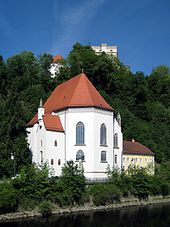St. Salvator (Passau)

The side church St. Salvator in Passau is located on the Ilzufer am Georgsberg directly below the fortress Oberhaus . To the north of the church is the former provost's office from 1501.
history
The Church of St. Salvator was built between 1479 and 1495 as an expiatory church for an alleged sacrifice of the host in place of a synagogue by an unknown master builder.
The Jews living in Passau in what is now the Ilzstadt district were said to have pierced a consecrated host with a knife in 1477, after which their blood flowed. The accused were burned, the Jews expelled from Passau, the synagogue and the Jewish quarter torn down. The process was shown drastically on a woodcut, and the knife used for the alleged desecration was turned into a relic .
On August 14, 1479, Bishop Ulrich von Nussdorf laid the foundation stone for the church. The church was consecrated in 1483 as the "Crypt of the Holy Cross". The collegiate foundation St. Salvator to support the pilgrimage was founded in 1490 by Bishop Christoph von Schachner . The parishes of Ilzstadt, Gottsdorf , Hohenau , Obernzell , Perlesreut , Straßkirchen and Untergriesbach were incorporated into the monastery.
The church of St. Salvator served to maintain church anti-Judaism in the city for several centuries.
However, the pilgrimage never achieved the significance of the comparable "Deggendorfer grace" at the grave church in Deggendorf . Due to the impoverishment of the monastery, dean and canon positions could no longer be filled from 1570. Bishop Urban von Trennbach transformed it into a so-called Realpropstei, which was subsequently awarded to a Passau cathedral chapter.
The last provost handed over the incorporated collegiate parishes to the prince-bishop in 1788. Since the secularization of 1803 the monastery has been finally dissolved; the church was profaned. In 1811 the church was sold to a saltpeter burner who turned it into an apartment. Most of the facility was destroyed. In 1842, Bishop Heinrich von Hofstätter bought the church back and had it regotified. After the consecration in 1861, English ladies received the building. Today the church serves as a concert hall, which is valued for its acoustics. It is only accessible during exhibitions or concerts.
art
The two-story main church rises above the crypt. The chronicler Carl Seyffert wrote in 1788: “ Here three churches are built on top of each other, which seems strange to one who has never seen such a thing. “The wall frescoes are from 1505. The gallery chapel ambulance is striking, it served to show the“ holy objects ”, the objects associated with the alleged sacrifice of the host. These were kept in a chapel in the south-east corner of the surrounding upper floor. The rib vault , completed in 1570, is extraordinarily intricate. On the west gallery there is an unusually large neo-Gothic altar, other fittings are missing.
The so-called host sacrilege was also depicted in the 17th, 18th and 19th centuries on rows of panels, some of which are now in the Upper House Museum.
proof
- ^ Jewish history in Passau Alemannia Judaica
- ↑ Gottfried Schäffer, Gregor Peda: Pilgrimages in the Passauer Land. P. 17.
literature
- Gottfried Schäffer , Gregor Peda: Pilgrimages in the Passau region. Pannonia-Verlag, Freilassing 1978, ISBN 3-7897-0069-X .
- Anton Mayer: The founding of St. Salvator in Passau - history and legend. In: Journal for Bavarian State History. Volume 18, 1955, pp. 256-278, ( digitized version ).
Web links
Coordinates: 48 ° 34 ′ 35.8 " N , 13 ° 28 ′ 22.9" E

